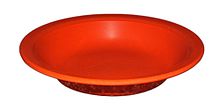- Melamine resin
-
Melamine resin or melamine formaldehyde (also shortened to melamine) is a hard, thermosetting plastic material made from melamine and formaldehyde by polymerization. In its butylated form, it is dissolved in n-butanol and xylene. It is then used to cross-link with alkyd, epoxy, acrylic and polyester resins, used in surface coatings. There are many types, varying from very slow to very fast curing.
Contents
Applications
In the kitchen
Melamine resin is often used in kitchen utensils and plates (such as Melmac). Melamine resin utensils and bowls are not microwave safe, as they absorb the microwave radiation and heat up.[1] As with all thermosetting materials, melamine resin cannot be melted and, therefore, cannot be recycled through melting.
A melamine-resin ladle
During the late 1950s and 1960s melamine tableware became highly fashionable. Aided crucially by the stylish modern designs of A. H. Woodfull and the Product Design Unit of British Industrial Plastics, it was thought to threaten the dominant position of ceramics in the market. The tendency of melamine cups and plates to stain and scratch led sales to decline in the late 1960s, however, and eventually the material became largely restricted to the camping and nursery market.[2]
Construction material
Melamine resin is the main constituent of high-pressure laminates, such as Formica and Arborite, and of laminate flooring. Melamine-resin tile wall panels can also be used as whiteboards.
Melamine & LEED: Phenol formaldehyde (PF) is used typically used as the binder / resin in hard-surface countertop materials, such as those used in lab desks. Melamine formaldehyde (MF) is a related compound used in plastic laminate and overlay materials. Formaldehyde is more tightly bound in PF and MF than it is in Urea Formaldehyde, reducing emissions. LEED v2.2's EQ Credit 4.4 precludes the use of Urea-Formaldehyde, but allows the use of Melamine Formaldehyde.Cabinet and furniture making
Melamine resin often is used to saturate decorative paper that is laminated under heat and pressure and then pasted onto particle board; the resulting panel is often called melamine and commonly used in ready-to-assemble furniture and inexpensive kitchen cabinets.
Melamine is available in different sizes and thicknesses, as well as a large number of colors and patterns. The sheets are heavy; the resin is prone to chipping when being cut with conventional table saws.[3]
See also
- Melamine foam is a special form of melamine resin. It is used mainly as an insulating and soundproofing material and more recently as a cleaning abrasive.
- Formica is a brand of composite materials manufactured by the Formica Corporation. In common use, the term refers to the company's classic product, a heat-resistant, wipe-clean, plastic laminate of paper or fabric with melamine resin.
References
- ^ Anne Field (2003-06-24). "Melamine Plastic". Home Maintenance and Repair. Michigan State University Extension. http://web1.msue.msu.edu/imp/mod02/01500096.html.
- ^ "The Rise and Fall of Melamine Tableware". plastiquarian (Plastics Historical Society) (32): 10. Summer 2004. Archived from the original on 2008-06-25. http://web.archive.org/web/20080625052055/http://www.plastiquarian.com/styr3n3/pqs/pq32.htm. Retrieved 2008-12-12.
- ^ "Melamine". Pro Woodworking Tips.com. http://www.prowoodworkingtips.com/Melamine.html.
Categories:- Kitchenware
- Building materials
- Organic polymers
- Thermosetting plastics
Wikimedia Foundation. 2010.



